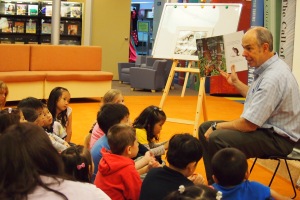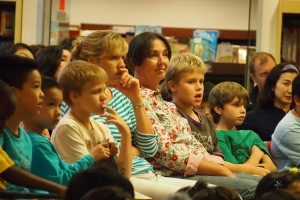When you walk into someone’s home for the first time, you can tell a lot about what they value. Statues and paintings from around the world indicate a love of travel. Photos of friends and family show a strong commitment to family. Furniture choice and placement, lighting, and the books on the shelves speak loudly about the people living there.
The same is true when you walk into any classroom. From what’s on the walls, to the way the furniture is arranged, the classroom communicates what is being taught, what is being celebrated and the shared values of the community. At our school, our rooms are arranged intentionally to support high standards, differentiated instruction, shared responsibility, independence, and to celebrate learning.

Kristi Mraz and Chris Lehman, two staff developers from the Teachers College Reading and Writing Project at Columbia University, came to the lower school at the end of January. In addition to providing professional development in reading content and methods, they provided insight into how we can further use the classroom environment as a way of making our instruction even more effective.
The Reggio Emilia approach to education dubs the environment as “the third teacher”. Parents are the first teacher and teachers are the second. The classroom environment then, is the third teacher. We take this idea to heart, so after Kristi and Chris’ visit, we spent some time as a faculty thinking about classroom design and what the implications are in three areas: the meeting area, the organization of materials, and the bulletin boards and charts.
Meeting Area
Gone are the days where students sat in neat rows and worked alone for the day. Our classrooms are intentionally set-up to allow for differentiated groupings: whole class, small group and individual work. Each homeroom classroom in the lower school is arranged with an empty space in the front of the room. This is the class meeting area- an important teaching space in the workshop model. The meeting area is where students come together for whole class instruction. Teachers demonstrate reading, writing, math, science and history strategies and concepts for all students and have them practice briefly before moving back to tables where students work individually or in small groups.
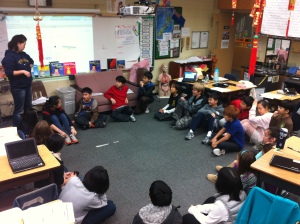
A grade 5 class debriefs at the end of writer's workshop.
Classroom Materials
The work of the class requires different tools and materials: from pencils to scissors, glue, tape, computers, books and papers; lower school classrooms typically have a lot of ‘stuff’. But how these items are arranged and accessed communicates the shared values of the room. In rooms where the materials are labeled and organized in a way that students can access them as needed without having to ask the teacher permission, it’s clear that students share the responsibility for their own learning with the teacher.
The clearest example of this idea is the classroom library which is at the heart of each room. In every classroom, hundreds of books are carefully and purposefully organized to scaffold students into becoming independent and enthusiastic readers. Students learn how to choose books at their level from this collection as they build important reading comprehension skills. What they read is not dictated to them; rather, students are taught how to make appropriate choices with guidance from their teacher. The classroom library includes a variety of reading levels and genres and thus supports the needs of a range of readers in each room.

This Grade 3 library is organized so students can access the books easily.
Charts and Bulletin Boards
When you look at what is on the classroom walls, the charts and displays tell the story of the learning happening in the room.
Charts are more than just wall hangings; they are crafted by the teacher to help students work with independence. Students use the charts to remind them what they are supposed to do, to see exemplary work to use as a model, or to remind them of the repertoire of strategies they can use to tackle a task. Charts are created during lessons with students so they are familiar with the content and can use them as needed.

This chart tells writers how they can make their writing feel more realistic.
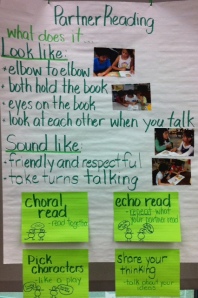
This chart can be used to remind partners how to make the most of their time together.
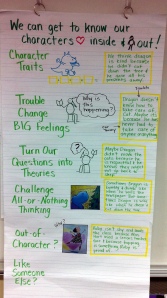
This chart lists ways readers can think about their characters and gives examples of what writing about that thinking would look like.
Bulletin boards in classrooms and hallways are created as a way to celebrate student work. But more than that, they highlight of the work of the unit as well. Teachers carefully teach editing and grammar skills appropriate to the developmental level of the child, and give the child every opportunity to make their work the best it can be before it goes on display. However, the work on display is the product of work children authentically completed on their own, and so it won’t always be perfect.
Here are examples of bulletin boards that not only celebrate the work of the student, but teach the viewer what the main goals of the unit were:

Grade 2 Realistic Fiction stories.

Each child chose a specific writing strategy they tried in the story and reflected on it.
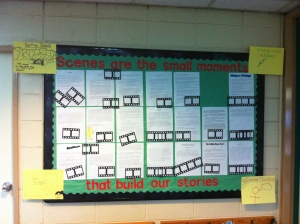
This board teaches the viewer what the important elements of a scene are (at the corners) and highlights student selected samples of their best scenes.
Marjorie Martinelli and Kristi Mraz highlighted the lower school over at Chartchums here and here. Their blog is a treasure trove of great charts and thought provoking explanations of the sound pedagogy they represent.
As a school, we continue to become more purposeful and intentional in all the ways we use our time with our students. We want the walls and spaces to teach them, and all the people in our community what we value.










